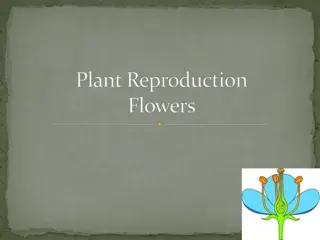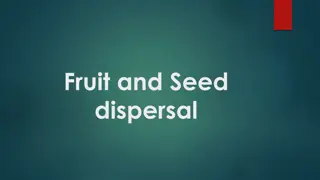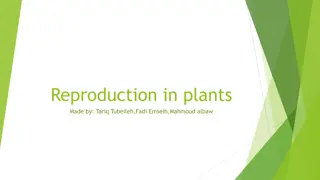Reproduction in Organisms: Overview and Types
Understanding the concept of reproduction in organisms, this content delves into the different modes of reproduction such as asexual and sexual, with examples and illustrations. It covers the life spans of various organisms and details various methods of asexual reproduction like fission, budding, spore formation, and vegetative propagation. The content emphasizes the structures involved in asexual reproduction and provides insights into binary and multiple fission, budding in organisms like Hydra, spore formation in fungi, and vegetative propagules in plants.
Download Presentation

Please find below an Image/Link to download the presentation.
The content on the website is provided AS IS for your information and personal use only. It may not be sold, licensed, or shared on other websites without obtaining consent from the author. Download presentation by click this link. If you encounter any issues during the download, it is possible that the publisher has removed the file from their server.
E N D
Presentation Transcript
REPRODUCTION IN ORGANISMS Presented by: Mr.Rajeshkukar Principal Kendriya Vidyalaya No.1 Devlali *
LIFE SPAN ORGANISMS May fly Butter fly crow crocodile man parrot tortoise Wheat plant Banyan tree LIFE SPAN 1 day 1-2 weeks 15 years 60 years 100years 140 years 100-150 years 6 months 200 years REPRODUCTION IN ORGANISM CLASS XII BIOLOGY *
TYPES OF REPRODUCTION ASEXUAL SEXUAL A single parent is involved. Two parents (a male and a female) No formation or fusion of gametes Formation and fusion of gametes Involves mitotic division Involves meiosis Individuals are genetically identical i.e. clone Individuals show variation i.e. offspring REPRODUCTION IN ORGANISM- CLASS XII BIOLOGY *
MODES OF ASEXUAL REPRODUCTION Fission- (a) binary (b) multiple Budding Spore formation Vegetative propagation REPRODUCTION IN ORGANISM- CLASS XII BIOLOGY *
BINARY FISSION Ex. Amoeba REPRODUCTION IN ORGANISM- CLASS XII BIOLOGY *
MULTIPLE FISSION Ex. Entamoeba REPRODUCTION IN ORGANISM- CLASS XII BIOLOGY *
BUDDING Ex. Hydra REPRODUCTION IN ORGANISM- CLASS XII BIOLOGY *
SPORE FORMATION Ex. Fungi REPRODUCTION IN ORGANISM- CLASS XII BIOLOGY *
ASEXUAL REPRODUCTIVE STRUCTURES Motile microscopic zoospores -(chlamydomonas) Conidia (penicillium) Buds (hydra) Gemmules- (sponges) REPRODUCTION IN ORGANISM- CLASS XII BIOLOGY *
VEGETATIVE PROPAGULES Runner- oxalis Sucker- mint Tuber- potato Offset- water hyacinth, pistia Bulb- onion, garlic Rhizome- ginger Bulbil- agave Leaf buds- Bryophyllum REPRODUCTION IN ORGANISM- CLASS XII BIOLOGY *
REPRODUCTION IN ORGANISM- CLASS XII BIOLOGY *
SEXUAL REPRODUCTION Sexual reproduction events Syngamy and fertilisation Pre-fertilisation Post-fertilisation Gametogenesis Gamete transfer REPRODUCTION IN ORGANISM- CLASS XII BIOLOGY *
PRE-FERTILISATION CHANGES (A) GAMETOGENESIS It is the process of formation of haploid male and female gametes. Gametes may be homogametes (isogametes) or heterogametes. In heterogametes the male gamete is called antherozoid or sperm and the female gamete is called the ovum. REPRODUCTION IN ORGANISM- CLASS XII BIOLOGY *
PRE-FERTILISATION CHANGES (A) GAMETOGENESIS If the parent body is haploid gametes are formed by mitosis, if diploid gametes are formed by meiosis. An organism may be homothallic/monoecious or heterothallic/dioecious. REPRODUCTION IN ORGANISM- CLASS XII BIOLOGY *
PRE FERTILIZATION CHANGES (B) GAMETE TRANSFER Fusion of male and female gamete is called fertilisation. So male and female gamete must be brought together. In some organisms both gametes are motile (algae) but in most cases male gamete is motile where as female is not. Algae, bryophytes and pteredophytes, water is the medium for gamete transfer REPRODUCTION IN ORGANISM- CLASS XII BIOLOGY *
PRE FERTILIZATION CHANGES (B) GAMETE TRANSFER Pollination is the method of gamete transfer in higher plants as pollen grains contain male gametes. The number of male gametes are thousand times the number of female gametes as there is loss of male gametes during transfer. In dioecious animals there is special mechanism for gamete transfer. REPRODUCTION IN ORGANISM- CLASS XII BIOLOGY *
SYNGAMY AND FERTILISATION It results in the formation of diploid zygote. In some animals like rotifers, honey bees, some lizards and birds (turkey) female gametes develop in to organism without fertilisation, such a phenomenon is called parthenogenesis. REPRODUCTION IN ORGANISM- CLASS XII BIOLOGY *
POST-FERTILISATION EVENTS The events after zygote formation is called post- fertilisation events. Zygote development (i) type of life cycle of organism and (ii) the environment it is exposed to. In algae and fungi it develops a thick wall around it to resist desiccations and damage and undergoes a period of rest. REPRODUCTION IN ORGANISM- CLASS XII BIOLOGY *
POST-FERTILISATION EVENTS Organisms showing haplontic life cycle, zygote undergoes meiosis. While organisms showing diplontic life-cycle undergoes mitosis. The zygote develops into an embryo. Embryogenesis involves (i) cell division (ii) cell enlargement or growth (iii) cell differentiation. In oviparous animals zygote development occurs outside of female s body, they are egg laying e.g. reptiles, birds. REPRODUCTION IN ORGANISM- CLASS XII BIOLOGY *
POST-FERTILISATION EVENTS In viviparous animals zygote development occurs inside of female s body. They give birth to young individuals. E.g. mammals In plants zygote is formed inside ovule, where it develops into embryo, then ovule becomes seed and ovary into fruit. Germination of seeds produce new plants. REPRODUCTION IN ORGANISM- CLASS XII BIOLOGY *
TYPES OF FERTILISATION EXTERNAL FERTILISATION Syngamy occurs outside of the body of organisms. INTERNAL FERTILISATION Syngamy occurs inside of the body of organisms. Large number of gamets (male & female) are released into surrounding medium. E.g. bony fish, amphibians Number of ova are less, but large number of male gametes are formed. E.g. birds, mammals, earthworm. REPRODUCTION IN ORGANISM- CLASS XII BIOLOGY *
TYPES OF ANIMALS OVIPAROUS VIVIPAROUS Animals lay fertilise or unfertilised eggs. Give birth to young individuals. Eggs have calcareous shell to protect from the harsh environment. No shell, they are protected inside the mother s body. REPRODUCTION IN ORGANISM- CLASS XII BIOLOGY *
REPRODUCTION IN ORGANISM- CLASS XII BIOLOGY *























